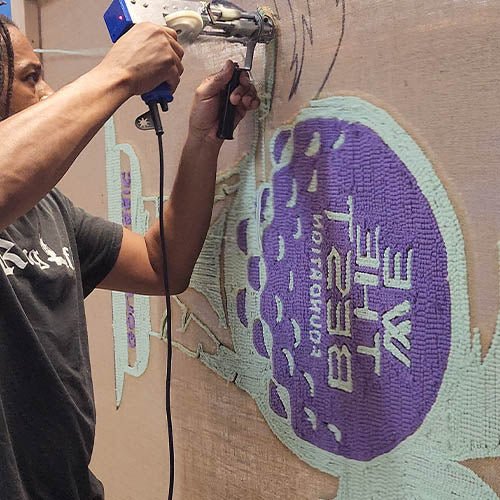
5 Common Tufting Mistakes (and How to Fix Them)
5 Tufting Mistakes That Ruin Your Flow (and How to Avoid Them for Good)
Tufting looks simple when you watch those hypnotic videos—but if you've ever jammed your gun mid-line or ended up with a saggy rug, you know: there's a learning curve. Most issues come down to a few core mistakes that are easy to fix once you know what to look for.
Let’s break down five of the most common tufting mishaps—and how to prevent them before they throw off your rhythm.
1. Using the Wrong Backing Cloth
The Problem: Your tufting gun snags, skips, or jams every few inches.
The Cause: Cheap or inconsistent weave backing cloth makes it hard for the needle to punch through smoothly.
The Fix:
Always use high-density primary tufting cloth (you’ll know it by the grid-like weave and slight stretch). It holds the yarn tight and supports clean lines. Bonus: fewer jams = less wear on your machine.
Pro tip: Stay away from monk’s cloth unless it’s specifically labeled for tufting—it’s usually too loose.
2. White-Knuckling the Tufting Gun
The Problem: Your lines are shaky, uneven, or "wobble" on curves.
The Cause: You're gripping the gun like it owes you money.
The Fix:
Let the gun do the work. Use a light, steady grip and move your whole arm—not just your wrist. Think of it like drawing with your shoulder instead of scribbling with your fingers.
Try practicing fluid movements on scrap cloth before jumping into your main design.
3. Zero Yarn Tension
The Problem: Loops aren't forming, or the yarn gets sucked too quickly.
The Cause: Your yarn is flopping around with no guidance.
The Fix:
Use a yarn guide setup or tension stand to control the feed. Tension helps regulate loop consistency and prevents skips. This one fix alone can make your rugs look way more professional.
DIY fix: Run your yarn through eye hooks or even the handle of a broomstick to create makeshift tension.
4. Rushing the Finishing Process
The Problem: Your rug backing peels or warps after a few uses.
The Cause: The glue wasn’t fully cured—or the wrong materials were used.
The Fix:
Let your rug glue cure overnight, minimum. Then press it down firmly with a felt backing to seal everything in. Skipping this step = floppy rugs that don’t hold their shape.
Invest in a glue that’s made for tufting. Carpentry glue won’t cut it.
5. Neglecting Gun Maintenance
The Problem: Uneven pile, strange vibrations, or dull lines.
The Cause: Gunked-up blades or dry gears.
The Fix:
Clean your tufting gun at least once a week. That means brushing out yarn fluff, checking the blade, and applying oil to the moving parts. Maintenance keeps your cuts clean and your machine alive.
Set a reminder—your gun needs more love than you think.
Final Word: It’s Not You—It’s Your Setup
Most tufting problems aren’t a lack of talent—they’re a lack of information. Fix the setup, learn the rhythm, and watch your work level up fast.
🧵 “I used to jam my gun constantly. Switched to proper cloth and it hasn’t happened since.”
– @TuftedByZai
📥 Grab the Free Tufting Starter Guide
Includes a tools checklist, beginner setup diagram, and a troubleshooting chart for quick fixes.
👉 [Download Now]
